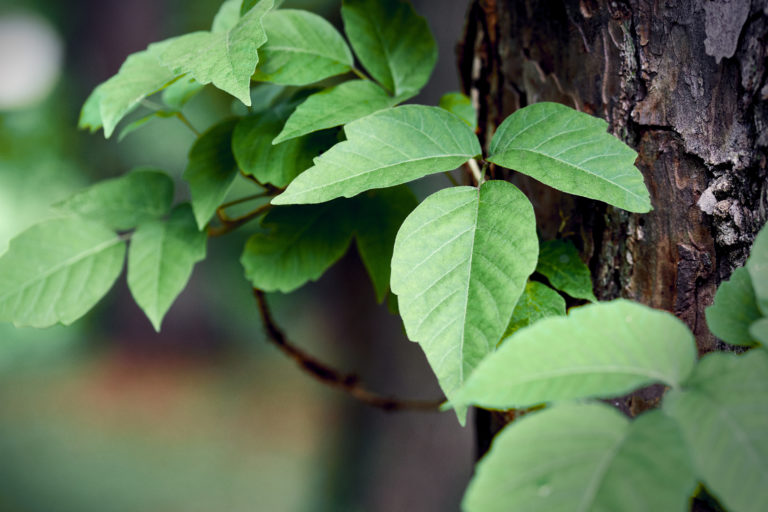Last updated on January 12th, 2024 at 02:57 pm

Anyone who’s ever ventured into the woods has heard the phrase “Leaves of three, let it be” as a warning to avoid poison ivy. Identifying this plant in nature is important because even a minor brush-up can result in a painful, itchy rash with blisters. The American Skin Association estimates that up to 85% of the population is allergic to poison ivy and its relatives: poison sumac and poison oak.
Hairy Vine? No Friend of Mine
Poison ivy, known botanically as Toxicodendron radicans, grows across nearly all of the United States, except for Alaska and Hawaii. And like most noxious weeds, it thrives in disturbed soil along woodlands, trails, and garden beds, concealing itself among the greenery. You can blame birds for its prolific growth. Poison ivy berries are an important food source for them, and the seeds are easily spread through their droppings.
Humans, unlike birds, are sensitive to the irritating sap produced by this plant and its relatives, called urushiol. Its name comes from the Japanese word for lacquer — “urushi.” For centuries, craftsmen in China, Japan, and Korea would collect this same urushiol-containing sap from a similar native plant (Toxicodendron vernicifluum) to use as a durable varnish on metal and wooden goods. Fortunately, there are no irritating effects once dried.
Urushiol is found in all parts of the poison ivy plant and can cause itching, redness, blistering, and pain mere hours after contact. This sap is hard to remove and can live on surfaces like shoes and gardening gloves for up to five years!
In Praise of Poison Ivy
In the 1700s, physician André-Ignace-Joseph Dufresnoy became interested in the potential health benefits of poison ivy and created herbal infusions in an attempt to cure various skin afflictions and even paralysis. These proved unsuccessful, and poison ivy is no longer used in this manner.
Surprisingly enough, people today use Rhus toxicodendron, the homeopathic form of poison ivy, for arthritis and joint pain. It helps when your joints stiffen with rest or are painful when rising, but the pain is relieved by movement. The 6C dilution can be found as one of the active ingredients in Arnicare Arthritis where it’s indicated for joint pain improved by motion and worsened by humidity.* Secondary uses include relieving small blisters that may occur with shingles, poison ivy, or cold sores.*
Learn more about Boiron Rhus tox in this video featuring pharmacist Gary Kracoff, NMD, RPh.
*Claims based on traditional homeopathic practice, not accepted medical evidence. Not FDA evaluated.







4 thoughts on “Poison Ivy: More Than Just a Nuisance”
My question is: Is Rhus Tox the same as Rhys toxicodendron? I have used the latter for poison ivy and it definitely helped. I can’t find it at Whole Foods any more, so would order direct from you. But I only found Rhus Tox here and I want to be sure this is the same thing.
Thanks.
Hi Marilyn,
Our Rhus tox is a homeopathic medicine prepared from Rhus toxicodendron L., which is more commonly known as poison ivy. Boiron’s indication for Rhus tox is joint pain improved by motion. Your health care professional may recommend or prescribe Rhus tox for different conditions, at various dilutions. Boiron chose an indication that is considered safe for self-medication and addresses a common condition.
Thanks!
If a person has an immediate severe reaction to poison ivy, will Rhus Tox cause a reaction since it is derived if poison ivy?
Hi Molly,
A homeopathic medicine above a 4C or 8X dilution is too diluted to cause the symptoms the raw material causes, i.e., Allium cepa 6C (from the onion) doesn’t make your eyes itchy or your nose runny.
Rhus tox is indicated for the relief of joint pain improved by motion.
Thanks!